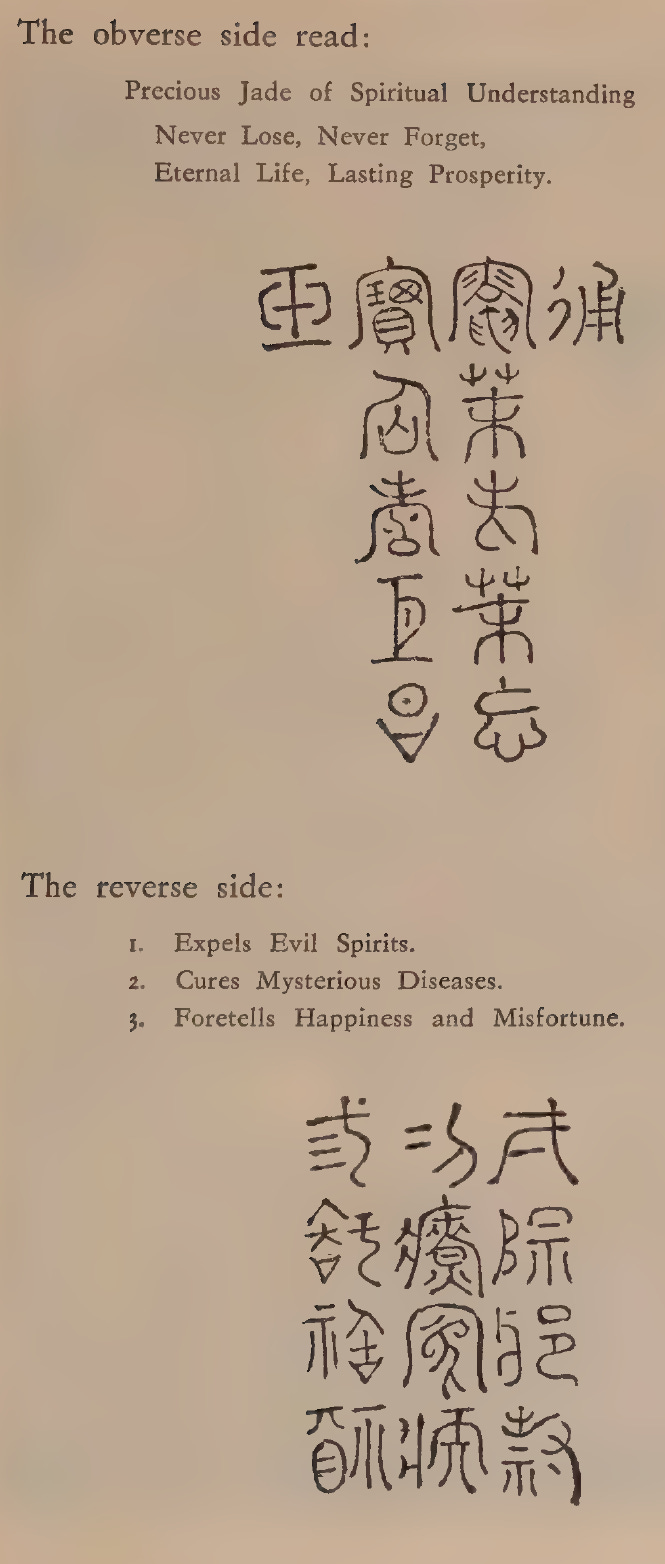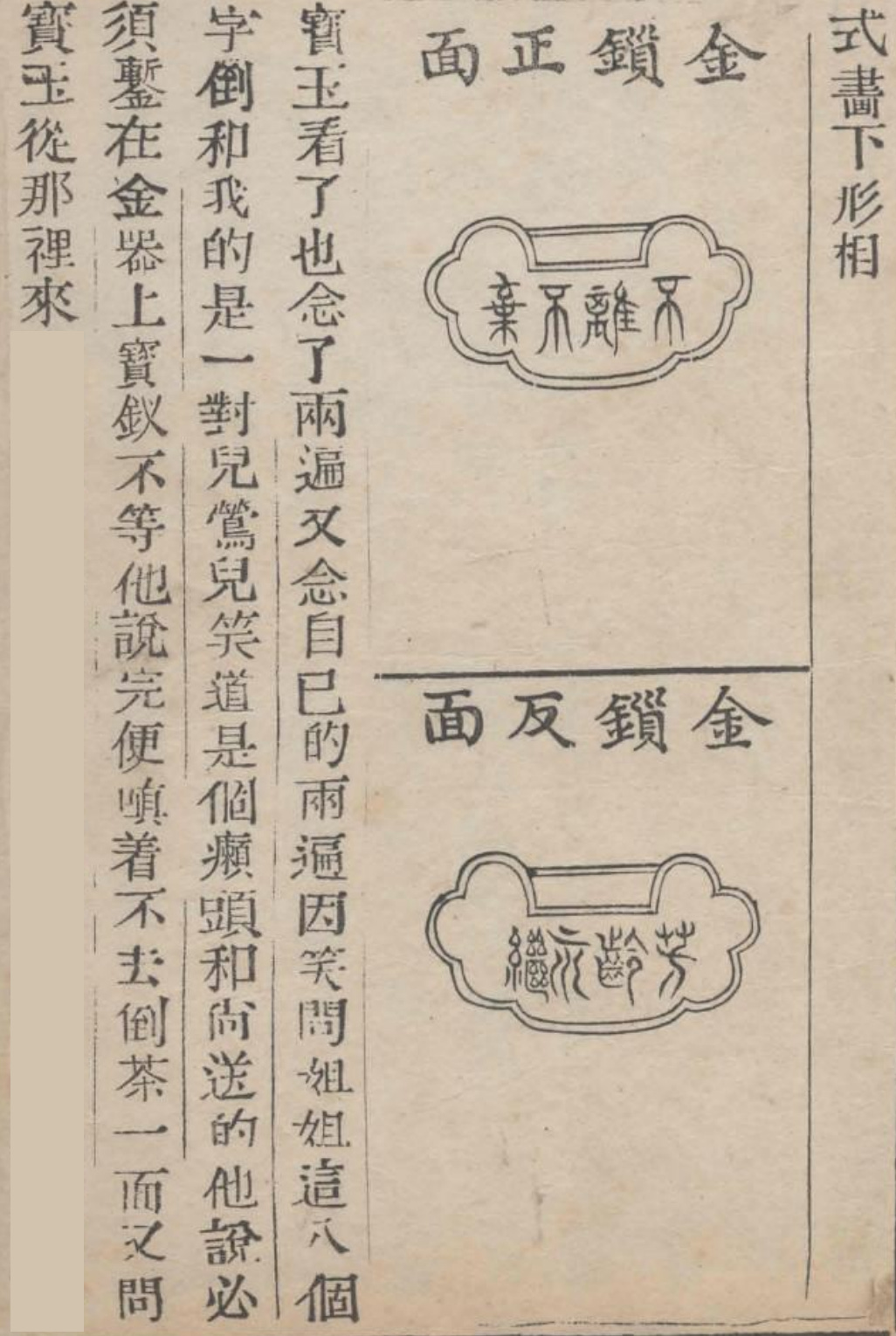The Inscriptions
This is an extremely important section of the book.
Jia Baoyu discovers that the inscriptions on his legendary jade are an exact match to the inscriptions on a necklace that Xue Baochai has. This was allegedly given to her by the same monk that had all the adventures with Zhen Shiyin earlier.
There are all sorts of interesting connotations brought up by this passage alone. Could it be that Xue Baochai, and not Lin Daiyu, is actually the one fated to be together with Jia Baoyu? Could it be that the religious men are meddling with the fate of Jia Baoyu and the girls for some unknown reason? Or could this all be a hoax created by the Wang family in hopes of forcing Jia Baoyu to be together with Xue Baochai in the end?
This is the sort of complex turning of the screws that you just don’t see in the average 才子佳人 romance novel.
My Translation
There was also a description of the history of its illusory form recorded on that useless stone, along with the seal script characters that the scabby monk had carved into it. These are reproduced in the image below.
However, the object’s true form is extremely small, since it was taken from the mouth of a newborn infant. It someone were to draw it to scale, the script would be too small to read, forcing the reader to strain her eyes. That would not be a pleasant experience. It’s been enlarged slightly to make it legible by lamplight or for a slightly drunk reader. This has been done to prevent anybody from wondering how an object large enough to contain these characters could fit in the mouth of an infant.
Front of the Precious Jade of Spiritual Understanding
The Precious Jade of Spiritual Understanding
Never lose me, never forget me;
Eternal life, enduring prosperity.
Back of the Precious Jade of Spiritual Understanding
1 It wards off evil spirits.
2 It cures mysterious sicknesses.
3 It foretells calamities and blessings.
After she finished loking, she turned the stone over to examine the front line closely. She read the words aloud:
“Never lose me, never forget me;
Eternal life, enduring prosperity.”
She read the lines aloud twice, and then turned to Ying’er and smiled. “Why are you standing here in a daze instead of going to get the tea?”
“Those two lines sound like a perfect match for the words on your necklace, miss,” said Ying’er, giggling.
Jia Baoyu perked up when he heard this. “So you have an inscription on your necklace, too? I want to take a look at it.”
“Don’t listen to her,” said Baochai. “There’s no inscription.”
“Dear Baochai,” said Baoyu, “if you were allowed to see mine, surely I can see yours, right?”
Baochai couldn’t withstand his pestering. “It just contains two auspicious phrases that somebody gave me,” she said, “and so I wear it every day. Otherwise, this heavy and cumbersome thing would be pointless.” And, as she spoke, she unbuttoned the top button of her jacket and took out the luminous, gem-encrusted, dazzling golden necklace from inside her crimson inner robe.
Baoyu held the locket in his hand and examined it. As expected, each side had four characters, making a total of eight characters forming two auspicious couplets. They have been reproduced in an illustration below:
Front of the golden locket:
Never leave, never abandon
Back of the golden locket:
Youth forever preserved
Baoyu looked it over and recited it aloud twice. He then read his own inscription aloud twice. “Baochai,” he said with a smile, “these eight characters seem to form a perfect pair with the ones on my jade.”
“A scabby headed monk gave it to her,” chimed in Ying’er. “He said that they must be engraved on a golden ornament.”
“Aren’t you going to get that tea?” Baochai cut her off angrily. She then changed the subject, asking Baoyu where he had just come from.
Translation Critique
Hawkes
Despite David Hawkes’ insistence in his introduction that he was translating everything in this book, he actually skips over a major chunk here. The paragraph describing the enlargement of the characters on Jia Baoyu’s jade do not exist anywhere in The Story of the Stone.
Yang
The Yangs translate the paragraph describing the size of the characters.
Similarly, the Yangs actually use a drawing of the characters written in the seal script:
They do the same for Xue Baochai’s inscriptions:
As you can see below, the 1792 printed edition of the novel also includes the same drawings, though they are a bit more formal and ornate than the ones in the Yang translation.
Chinese Text
那頑石亦曾記下他這幻相併癩僧所鐫篆文,今亦按圖畫於後面。但其真體最小,方從胎中小兒口中銜下,今若按式畫出,恐字跡過於微細,使觀者大費眼光,亦非暢事。所以略展放些,以便燈下醉中可閱。今註明此故,方不至以胎中之兒口有多大,怎得銜此狼犺蠢大之物為誚。
通靈寶玉正面
通靈寶玉
莫失莫忘
仙壽恆昌
通靈寶玉反面
弌除邪祟
弍療冤疾
弎知禍福
寶釵看畢,又重新翻過正面來細看。口裡念道:「莫失莫忘,仙壽恆昌。」唸了兩遍,乃回頭向鶯兒笑道:「你不去倒茶,也在這裡發呆作什麼?」鶯兒也嘻嘻的笑道:「我聽這兩句話倒像和姑娘項圈上的兩句話是一對兒。」
寶玉聽了,忙笑道:「原來姐姐那項圈上也有字?我也賞鑑賞鑑。」寶釵道:「你別聽他的話,沒有什麼字。」寶玉央及道:「好姐姐,你怎麼瞧我的呢?」寶釵被他纏不過,因說道:「也是個人給了兩句吉利話兒鏨上了,所以天天帶著;不然,沉甸甸的,有什麼趣兒?」一面說,一面解了排扣,從裡面大紅襖兒上將那珠寶晶瑩黃金燦爛的瓔珞摘出來。寶玉忙托著鎖看時,果然一面有四個字,兩面八個字,共成兩句吉讖,亦曾按式畫下形相:
金鎖正面
不離不棄
金鎖反面
芳齡永繼
寶玉看了,也念了兩遍,又念自己的兩遍,因笑問:「姐姐,這八個字倒和我的是一對兒。」鶯兒笑道:「是個癩頭和尚送的,他說必須鏨在金器上。」寶釵不等他說完,便嗔著:「不去倒茶?」一面又問寶玉從那裡來。
Translation Notes
暢事 means something that causes somebody to be happy.
The entire parenthetical first paragraph in this segment of the Chinese text is kind of bizarre, and we see the same bizarre nature when Xue Baochai’s inscription is described. This is a good early example of breaking the fourth wall, where the author is describing to the reader precisely what is happening in the text as if the reader were discussing the composition of the text directly with the author.
仙壽 means the long life of an immortal being.
恆昌 means everlasting prosperity.
弌, 弍, and 弎 are formal and archaic variants of the numbers 1, 2, and 3 (normally written 一, 二, 三).
賞鑑 means to look at and appreciate. Actually, in modern Chinese it’s written backwards, usually something like 鑒賞.
Jia Baoyu’s reply of 你怎麼瞧我的呢 is a pretty good example of Chinese as a contextual language. His question literally translates to “How were you able to see mine?” and is a rhetorical way of asking her how it could be fair that she could see his, but he couldn’t see hers.
瓔珞 means a jade or pearl necklace.
As you can see in the Chinese text above, the inscriptions on the amulets were written in seal script in the original text. It’s ornate and is not very easy to read. Most Chinese versions of the text you’ll find online inadvertently omit the inscription on the back side of Jia Baoyu’s jade. This is because most Chinese printings of the text present that text only as a photo of the seal script. Fortunately, there are some Chinese editions that also print more readable versions of the characters, such as this one:









Even as someone who doesn’t know Chinese, I really appreciate the fact that you list your translation, a translation critique and the original. When you’re just reading a printed copy you’re really at the mercy of the translator and as you mentioned they can omit whatever they would like without being honest about it.